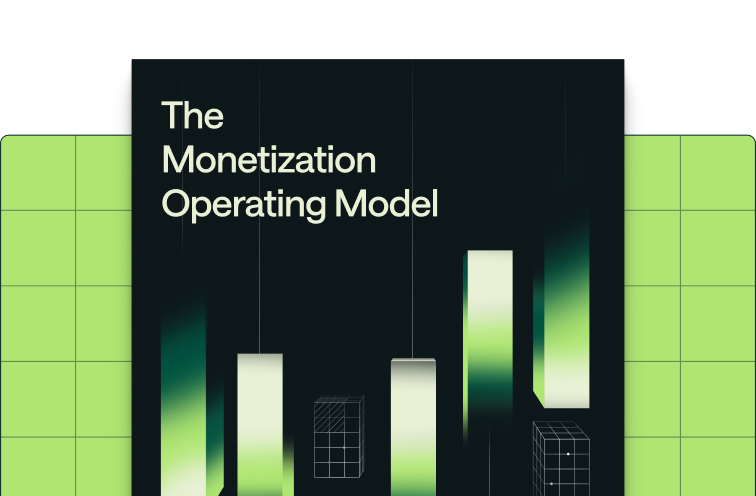Share
In today’s dynamic market, cloud and SaaS companies often employ multiple go-to-market (GTM) motions, including product-led growth, product-led sales, sales-led growth, and channel- or partner-led growth—or any combination of those motions. Each approach brings unique customer expectations around pricing and packaging, making pricing flexibility essential. Many companies adopt usage-based pricing models to align pricing with customer value, enabling them to adapt to diverse customer needs and maximize revenue potential. These models come with distinct advantages and trade-offs, influencing contract structures, billing methods, and cash flow management.
In this post, we’ll explore trade-offs for the most common SaaS pricing and commercial models* with usage-based and hybrid revenue strategies and look at how you can determine the best fit for your GTM motions.
*Here, commercial models refer to the structure that defines how customers pay, detailing terms, conditions, payment methods, and pricing for purchasing products or services.
1. Pay-As-You-Go (PayGo), paid in arrears
With a PayGo model, customers pay only for what they use, without any upfront commitments or contracts.
Key details
- Customers are billed in arrears based on consumption.
- Since there’s no upfront commitment, discounts are rare, and future price increases may apply.
Example
If a customer uses 1,000 units in one month at $2.00 per unit, they’ll receive a $2,000 invoice for that month at the end of their billing cycle.
Benefits
- Provides low friction and an accessible entry point, which is ideal for product-led growth
- Reduced sales and marketing overhead due to minimal commitment requirements
- Cost effective when used for self-serve motions and standardization at scale
- Allows subscription-based or seat-based companies to trial new add-on offerings without changing core pricing models
Considerations
- Unpredictable cash flow without upfront revenue
- Increased risk of fraud and collection complexity when extending credit to customers who pay in arrears
- To lower collection risk, PayGo customers with large invoices should be converted to other commercial models.
- Potential difficulties in recouping investments if customer acquisition costs are high, especially in models requiring setup or integration
Summary

Find out how to launch a PayGo model on Metronome.
2. PayGo, paid in advance with prepaid credits
This prepaid model involves upfront payments before usage, with automatic reload when balances fall below a set threshold.
Key Details
- Customers can purchase through self-serve workflows, with optional pre-approved, commit-based discounts built in.
- Prepaid units often have an expiration date, and unused credits typically do not roll over or get refunded after they expire.
- As the service is used, the prepaid balance decreases accordingly.
- When the balance reaches a specific threshold, the customer is automatically charged to reload the prepaid balance. If the reload is unsuccessful, access to the service may be suspended.
- If customers deplete their credit balance, they may be charged at an overage rate and revert to a paid-in-arrears PayGo payment model.
Example
OpenAI's prepaid billing model enables users to self-serve purchase credits up front, which are deducted based on API usage. These credits expire after one year and are nonrefundable. Users can easily set up auto-reload credits to maintain uninterrupted access to services.
Benefits
- Strong protection against fraud when securing payment up front—a widely favored approach in the AI industry
- Easier budgeting and expense tracking for customers when they prepay, and no large, unexpected charges at the end of a billing cycle
- More economical for customers with consistent usage patterns if the business offers discounts like reduced per-unit rates
- Ideal for product-led growth or product-led sales with minimum sales engagement required
- Ideal for markets with consistent, predictable customer payment behavior and minimal risk of disputes over unused balances
Considerations
- Low-latency alerts from real-time billing are essential for auto-reload mechanisms, preventing service disruptions for users and avoiding revenue loss
- Requiring upfront payment may hinder adoption, making this model more suitable for higher tier offerings, while lower tier or starter SKUs might benefit from a paid-in-arrears or a freemium model
Summary

Find out how to set up prepaid credits and learn how to set up robust alerts on commits and credits on Metronome.
3. Monthly minimum spend
With this model, the customer commits to spending a minimum amount per billing period (typically monthly or quarterly), without a long-term contract. This minimum commitment can apply to the full invoice or only to specific product categories.
Key Details
- Each month, the customer spends at least a pre-agreed minimum, regardless of actual usage.
- If they use less than the committed minimum within a billing period, they still pay for that period’s agreed-upon amount.
- If they use more than the minimum, they pay for the total amount used, and the overage amount is sometimes billed at a different rate than the agreed-upon minimum.
Example
- Mailchimp sets a minimum monthly charge based on the number of contacts and number of emails sent, ensuring a base revenue regardless of actual usage.
Benefits
- Provides a predictable baseline spend without requiring a long-term commitment
- Suitable for customers who prefer flexibility but can commit to consistent monthly usage
- Offers new customers an easy, clear-cut way to start using your product without heavy sizing exercises
- Ideal for product-led growth or product-led sales
Considerations
- May be less appealing for customers with high-spend accounts who prefer longer-term discounts
- May lead to customer dissatisfaction if customers feel they're overpaying due to lower-than-expected usage
- Requires more effort for customers to track and manage invoices when seasonal or variable usage fluctuates around the minimum threshold
Summary

Talk to our experts to see how we support this model.
4. Pre-paid commit
In this model, the customer commits to a specific spend or usage over a defined period, typically annually or multi-year. These contracts are negotiated based on anticipated usage, providing spending predictability that aligns with the customer’s budget planning.
Key Details
- Commit contracts involve detailed sales negotiation to finalize terms, ensuring alignment with both the customer’s budget and usage projections.
- Customers may lack the resources to pay the entire commit up front. Offering a flexible payment schedule, with installments and custom due dates, helps accommodate their financial planning.
- Customer access to the committed balance (also know as access schedule) is often tied to payment progress so that they can only use their balance in proportion to their payments. This approach mitigates the risk of noncollection by aligning usage access with the customer’s payment status, ensuring more balanced cash flow.
- Commit contracts typically specify which products or services fall under the commit, along with any applicable discounts. For companies with multiple product offerings, varying discounts and eligible offerings can help maximize revenue while protecting margins.
Example
Snowflake offers a prepaid commit model known as "Committed Capacity" or "Pre-Purchased Capacity." In this model, customers commit to a specific dollar-spend commitment over a defined period (typically one or more years) in exchange for discounted rates compared to on-demand pricing. If the committed capacity is exceeded, additional usage is billed at on-demand rates.
Benefits
- Provides predictable revenue and cash flow, allowing for longer-term investment on both sides
- Higher deployment success rates and long-term value realization for customers due to the upfront investment, which creates an urgency for customers to fully engage with the product
- Reduced collection risk—especially compared to post-paid models—by collecting payments in advance
- Predictable revenue and customer commitment that allow decisive resource allocation to support customer success and product improvements.
Considerations
- Best suited for upmarket customers in sales-assisted or sales-led models where a consultative approach is needed to size usage and scope effectively
- Rollover policy considerations
This policy defines how unused balances are handled at the end of the term, a key consideration for customers who may overestimate their spend due to ramp-up or adoption delays.- Churn risk mitigation if rollover policies are favorable—can serve as a valuable retention tool
- However, rolling over balances causes delays in revenue recognition, which may impact future sales and complicate financial forecasting.
- Overage policy considerations
This policy defines charges for customers who exceed their balance before the term ends.- Well-designed overage policies that avoid overly punitive rates can encourage additional commitment and support smooth customer expansions, thus preventing strain on relationships
Summary

Find out how to launch an enterprise commit model on Metronome.
5. Post-paid commit with true-up
In this model, the customer commits to a specified spend or usage over a set period without upfront payment. Instead, they are invoiced in arrears based on actual consumption, with a true-up adjustment if their spending falls short of the commitment.
Key Details
- Customers receive a discounted rate in exchange for the commitment.
- Customers are billed at the end of each billing cycle based on actual usage.
- If they use less than the commitment by the end of the period, a true-up charge is applied to cover the shortfall.
- The model allows customers to exceed their commitment without penalties
Example
The AWS Enterprise Discount Program (EDP) offers an option that does not require an upfront payment, which allows companies to commit to a minimum annual spend and secure discounted rates without an initial payment. True-up adjustments are made if actual usage differs from the committed amount.
Benefits
- Ideal for self-serve models with lower customer acquisition costs (CAC) and marginal delivery costs, where customers can easily reach the commitment
- More attractive to customers, and easier entry, without an upfront payment requirement
- Assists in securing large enterprise deals with customers who prioritize strategic use of capital and can leverage paying in arrears to keep funds available for high-return investments, rather than tying up cash in vendor deposits
Considerations
- Increased risk of nonpayment due to challenges in collecting true-up fees from customers who may not renew
- Not suitable for B2C due to fraud risk and collections overhead.
- Ability to incentivize up-front payment and mitigate financial risk by offering larger discounts with prepaid commit and smaller discounts with postpaid commit to
- Ability to reserve the postpaid commit model solely for enterprise customers where there is greater confidence in payment collection due to established relationships and creditworthiness
Summary

Find out how to model a post-paid commit model with Metronome.
6. Cloud marketplaces
Cloud marketplaces offer an accessible route for companies to tap into a large customer base, leveraging the marketplace’s built-in audience, procurement systems, and pre-committed budget.
Benefits
- Lower acquisition costs through the existing customer pool and streamlined purchasing processes Marketplaces provide
- Flexibility for budget-conscious buyers who want to use pre-committed funds (public or private) with cloud service providers
- Ability to cater to diverse customer needs through various pricing options, including PayGo, subscriptions, commit, and bring-your-own-license (BYOL) models
Considerations
- Negative impact on margins due to marketplace fees
- Limited direct engagement with customers since marketplaces often control the relationship
- Future risks, including changes in marketplace policies or fees, which make it essential to weigh the risks of marketplace reliance against the benefits
Summary

Find out how to invoice through marketplaces with Metronome.
[fs-toc-omit]Next Steps
Each pricing model offers distinct trade-offs. Selecting the right one helps you align with customer expectations, GTM strategy, and cash flow goals. Whether you’re leveraging a PayGo model for easy entry or a prepaid commit for predictable B2B revenue, aligning your pricing approach with your business strategy is key to ensuring both flexibility and sustained growth.

Metronome is the only usage-based billing platform designed to scale with you, from standard self-serve plans to complex enterprise agreements. Whether launching your first product or expanding upmarket, Metronome empowers you to deploy optimal pricing with a full suite of ready-to-use pricing tools.
Visit the pricing lever page to explore how you can optimize your pricing strategy.











